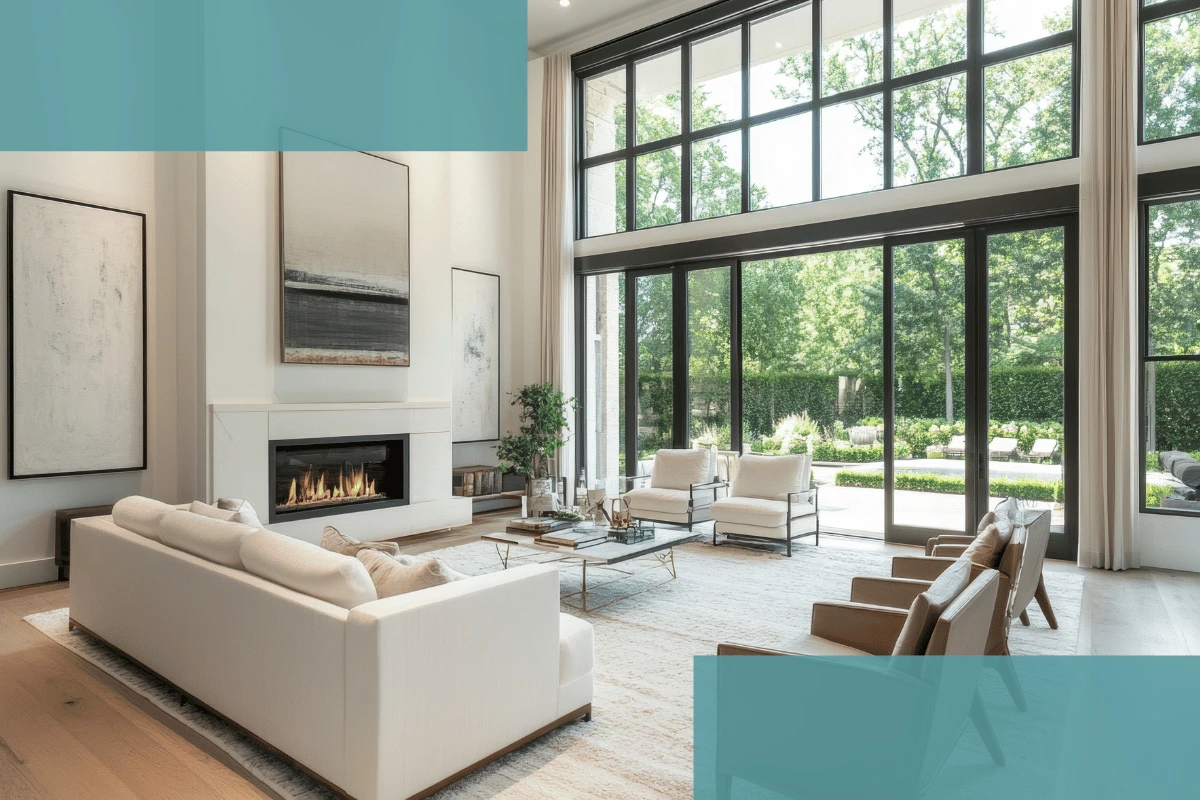You spend the weekend moving furniture, hanging art, and finally step back to admire your freshly decorated living room. But something’s off. It doesn’t feel cozy or inviting. Frustrating, right? You see those effortless rooms on Instagram or in magazines, and your space just doesn’t measure up.
Creating a beautiful, functional living room usually comes down to avoiding a few common, easy-to-fix mistakes. They’re not major design fails, just simple issues with scale, placement, and lighting that can throw off the whole vibe.
In this post, we break down the most common decorating mistakes we see and, more importantly, how to fix them. By the end, you’ll know exactly how to turn your space from flat to amazing.
Mistake #1: The “Too Much” and “Too Little” Furniture Problem
This one’s super common, and it comes in two parts. First, the “too much” problem. You buy a big, comfy sectional that seemed perfect in the showroom, but once it’s in your smaller living room, it completely takes over. The space feels cramped, walking around is awkward, and everything looks crowded.
Then there’s the “too little” problem. Maybe you have a large, open-concept space, but your small loveseat and a couple of chairs look like they’re floating in the middle of it. The room feels empty, cold, and unbalanced.
And then there’s the classic move: pushing all the furniture up against the walls. It might seem like it’ll make the room feel bigger, but it actually does the opposite. It leaves an odd, empty space in the center and makes the layout feel disconnected.
The Fix: Measure, Float, and Visualize
First things first: measure everything. Measure your room, the furniture you already have, and anything you’re thinking about buying. No exceptions. If you’re shopping, grab some painter’s tape and outline the size of that new sofa or chair on your floor.
Next, stop pushing all your furniture against the walls. Try floating your pieces instead. Pull your sofa and chairs a few inches or even a few feet away from the walls. This instantly makes the space feel more inviting and dynamic. Arrange your seating so it encourages conversation. A sofa facing two chairs with a coffee table in between is a classic setup for a reason. It’s cozy and welcoming. Even in a small room, moving the sofa out just six inches can completely change the vibe.
Mistake #2: Poor Lighting Choices
Depending on one light source is a major decorating mistake because it flattens the room, dulls the colors, and creates a sterile, uninviting look.
A well-designed room uses light the way a painter uses color. When you rely on just one fixture, you miss out on the depth and warmth that layered lighting brings. Every space needs different types of light for different moods and purposes, and one fixture simply can’t do it all.
The Fix: Layer Up Your Light
Lighting works best in three layers: ambient, task, and accent.
- Ambient Lighting: This is your general light. Keep the overhead fixture, but add a dimmer switch. Dimmers are essential for setting the right mood.
- Task Lighting: This is focused light for specific activities, like reading or working. Floor lamps near the sofa and table lamps on side tables provide a warm, comfortable glow that makes the space feel inviting.
- Accent Lighting: This is where you highlight what matters. Use picture lights, wall sconces, or small spotlights to draw attention to artwork, a textured wall, or a bookshelf. Accent lighting adds depth and gives the room a finished, polished feel.
Combining overhead, task, and accent lights lets you adjust the atmosphere throughout the day and night. It’s a simple update that completely transforms the feel of your living room.
Read more: Illuminate Your Living Room with Style: Lighting Tips and Tricks
Mistake #3: Rug Placement Errors
We call this the “postage stamp” rug mistake. You have a beautiful, spacious living room, but the rug you picked is way too small. It sits awkwardly in the middle, maybe just under the coffee table, and it looks exactly like a postage stamp stuck to the floor. This is a surefire way to make your room feel smaller and disconnected. A rug that’s too small doesn’t anchor the space; it just floats there doing nothing.
Another common mistake is having a rug that’s a decent size, but all the furniture sits around it instead of on it. The whole point of a rug is to define a zone, and if the furniture that belongs to that zone isn’t touching it, the rug can’t do its job.
The Fix: Go Big
For rugs, the rule is simple: bigger is better. Don’t be afraid to choose a large rug because it’s the foundation of your seating area. The ideal rug size should allow at least the front two legs of all your main seating pieces (sofa, loveseat, armchairs) to rest comfortably on it. Doing this instantly anchors the space and makes your seating arrangement look intentional and cohesive.
If your living room is especially large, pick a rug big enough for all the furniture to sit completely on it. That’s the gold standard for creating a defined, luxurious, and grounded look. A properly sized rug is one of the most effective ways to pull your living room together and make it feel complete.
Mistake #4: Neglecting Window Treatments
People spend tons of time picking out furniture and paint colors, then hang curtains right above the window frame or choose ones that are too narrow. The result is a look that cuts the wall short, makes the windows feel smaller, and can make the whole room look a bit off-balance.
Another common issue is using heavy, dark, light-blocking curtains when they aren’t really needed. Those can make a space feel darker than it has to be, especially during the day. Letting in more natural light instantly makes a room feel brighter, fresher, and more inviting.
The Fix: Go High and Wide
The secret to great window treatments is to hang them high and wide. Mount the curtain rod several inches above the window frame, closer to the ceiling than to the top of the window, and extend the rod past the sides of the window. This simple trick makes your windows look much larger and gives the room a taller, more open feel.
As for the curtains themselves, unless you really need blackout ones, go for light fabrics that let soft, natural light filter through. Sheers or linen blends are great for that. And when you pull the curtains open, make sure they sit on the wall, not covering the glass, so you can let in as much light as possible.
Read more: The Dos and Don’ts of Designing Around a Wall of Windows
Mistake #5: Lack of a Cohesive Color Palette
Ever walked into a room and felt like your eyes didn’t know where to land? That’s usually a sign the space lacks a cohesive color palette. It’s either overflowing with too many clashing colors, like a rainbow exploded in your living room, or it’s gone too far in the other direction. Everything is the exact same shade. You know the look: beige sofa, beige rug, beige pillows. Both extremes leave the room feeling flat, chaotic, or just plain dull. A well-designed space needs balance, visual interest, and a sense of harmony.
The Fix: Follow the 60-30-10 Rule
The 60-30-10 rule is the simplest way to create balance in any room. It’s basically a formula for a space that feels pulled together without being boring.
- 60% is your dominant color. This usually covers your walls, your largest piece of furniture (like the sofa), and your area rug. It sets the tone and mood for the space.
- 30% is your secondary color. This should be about half as much as your dominant color and can show up in things like accent chairs, curtains, or a painted feature wall. It adds depth and contrast.
- 10% is your accent color. This is where you can have fun. Use it for pops of color in your throw pillows, artwork, decor, or flowers. It’s the jewelry of the room, the little details that make everything feel complete.
When choosing your colors, grab a color wheel. You can’t go wrong using a complementary scheme (colors opposite each other) or an analogous one (colors next to each other). This simple approach instantly brings harmony and sophistication to any space.
Read more: 9 Living Room Layout Ideas to Try for Your Next Remodel
If you have tried these tips and still feel stuck, or if you are in Lafayette or nearby and want some expert help, our team is here for you. We offer complimentary interior design services because we genuinely want you to love your home. Book a consultation with our design team today and let us bring your space to life.

